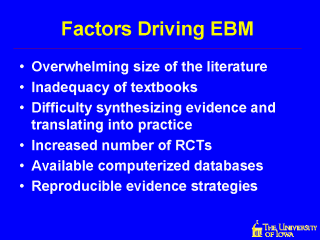| front |1 |2 |3 |4 |5 |6 |7 |8 |9 |10 |11 |12 |13 |14 |15 |16 |17 |18 |19 |20 |21 |22 |23 |24 |25 |26 |27 |28 |29 |30 |31 |32 |33 |34 |35 |36 |37 |38 |39 |40 |41 |review |
 |
Clearly, one
of the overriding factors has been the explosive growth of the medical
literature. The development of the Internet continues to expand the quantity
and availability of medical information. The problem has been how to quickly
and efficiently obtain high-quality, information that is relevant to each
patient or clinical encounter, in both inpatient and outpatient settings. Textbooks, while compiling a lot of information in one location, are frequently out-of-date in key areas by the time they are published. Because of the overwhelming volume of medical literature, it has been difficult to sort through and extract what is needed for one's unique practice. Although randomized controlled trials (RCTs) are expensive and time-consuming to conduct, their numbers increase because they provide essential scientific information particularly regarding interventions which may carry significant risks. The development of an array of computerized databases and new evidence strategies has facilitated the growth of EBM. |